|
| Page: [Previous] [Next] 1 2 |
| (1) Posted by Geoff Foster [Thursday, Apr 1, 2010 02:19] |
Best #2 cross-check problems
A friend of mine thinks that, since the traditional #2 is almost "played out", it would be good to compile a collection of the best traditional #2 problems, with about 5 problems for each of the main themes. I'd like to start with cross-checkers, so here are three very good ones. Do you agree that these are three of the very best, or do you have your own favourites?
Comins Mansfield, 1 Prize, Good Companions, 1917/III
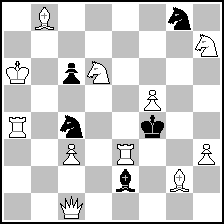 (= 11+5 ) (= 11+5 )
1.Be4! (2.Sxc4)
1...Sxd6+ 2.Bd3
1...Sxe3+ 2.Sb5
1...Se5+ 2.Rd3
1...Sd2+ 2.Sc4 (threat)
Charles G Watney (after Mendes de Moraes & Promislo), 2 Prize, Good Companions, 1922
 (= 8+10 ) (= 8+10 )
1.Sxd6! (2.Qc8)
1...Qxd6+ 2.Sc5
1...Sxd6+ 2.Rd4
1...Sc5+,Sd2+ 2.Sc4
1...Qd4+ 2.Sc4
1...Qxd5 2.Sf7
1...exd6 2.Qe8
1...Sb6,Sc7 2.S(x)c7
Gerald F Anderson, 1 Prize, The Observer, 1961
 (= 13+13 ) (= 13+13 )
1.Qb6! (2.Se4)
1...Sf~+ 2.Se4 (threat)
1...Sxd6+ 2.Sd3
1...Sd4+ 2.Rf5
1...exf6+ 2.Sb7
1...exd6+ 2.Sd7
1...Kxf6 2.Qb2
1...Kxd6 2.Rd4
|
|
| (2) Posted by Sarah Hornecker [Thursday, Apr 1, 2010 05:05] |
http://de.wikipedia.org/w/index.php?title=Marjan_Kovačević&oldid=71175133#Kompositionsbeispiel
|
|
| (3) Posted by Mihail Croitor [Thursday, Apr 1, 2010 09:00] |
did is correct that more checks is better?!
for me the best cross-check problem is the next:
 (= 5+6 ) (= 5+6 )
Anderson, Gerald Frank
Il Secolo, 1921, 1st Prize
|
|
| (4) Posted by Miodrag Mladenović [Friday, Apr 2, 2010 19:15] |
How about this one:
Marjan Kovačević
1st Pr. The Problemist 1991
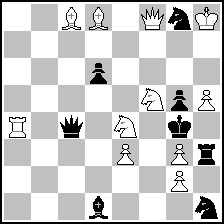 (= 11+8 ) (= 11+8 )
#2
1.Qh6? [2.Qxg5#] Rxh5! [2.Sh6?]
1.Qg7? [2.Qxg5#] Qd4! [2.Sg7?]
1.Qf6? [2.Qxg5#] Qc3! [2.Sf6?]
1.Qe7! [2.Qxg5#]
1...Rxh5+ 2.Sh6#
1...Qd4+ 2.Sg7#
1...Qc3+ 2.Sf6#
|
|
| (5) Posted by Geoff Foster [Saturday, Apr 3, 2010 04:50] |
Many thanks to Siegfried and Misha for showing the marvellous problems by Marjan. The problem above was quoted by David Shire in his article "The TwoMovers of Marjan Kovacevic", in the July 2007 issue of "The Problemist". The following problem was also in the article.
Marjan Kovacevic, 1 Prize, diagrammes 1991 (v)
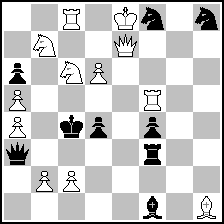 (= 12+9 ) (= 12+9 )
1...Qe3 2.Rc5
1...Re3 2.Bd5
1.Qe5? (2.Qd5,Qxd4) Qe3! (2.Rc5?)
1.Qe4? (2.Qd5,Qxd4) Re3! (2.Bd5?)
1.Qe1! (2.Sb4)
1...Qe3+ 2.Se7
1...Re3+ 2.Se5
1...Qc3 2.Rc5
1...Rc3 2.Bd5
1...d3 2.Qe4
1...Sd7 2.Qe6
The article discussed 21 of Marjan's problems. If anyone is interested then I could quote some more problems from the article in a separate thread (maybe even reproduce the entire article!).
|
|
| (6) Posted by Hauke Reddmann [Saturday, Apr 3, 2010 15:50] |
Tricky business. If I should offhand cite a x+ problem
that impressed me I would name that by Imre Telkes (in the
Murkisch book, haven't it here).
I would *definitively* not consider Marjans problems here:
he's a "modern" composer, meaning that he's got all the
new-fangled more-phases stuff which surely adds to the
quality of a problem...but I think the idea of the proposed
anthology is to show the themes in purest form.*
This means the quality should *only* come from the
x+ and things that revolve around it. E.g. how White
suddenly exposes his own king. Or the checking piece
doing different nth degree parades. <mode=Bruce Willis>
I see dead people (Vaux Wilson, to be specific).
We could also pre-sort a few dozen problems and make a
collective judge panel. We have to do that fast because
not only the 2# is dying out but also the classic
composers who grew up with the classic themes.
Hauke
* Consider e.g. my first problem on this page:
http://www.bambam42.de/problem/problem3.html
Already too modern - 2 phases and no exposing key,
on the contrary, uncovered set play.
|
|
| (7) Posted by Jacques Rotenberg [Saturday, Apr 3, 2010 23:16]; edited by Jacques Rotenberg [10-04-03] |
Whose is this version of the problem of Marjan ??
The original version is :
Marjan Kovacevic
Diagrammes 1991 1st Prize
 (= 14+9 ) (= 14+9 )
2#
it seems far better :
The try
1.g×f7? [2.Qe6‡]
1…Qe3 2.Rc5‡
1…Re3 2.Bd5‡
but 1…Bh3!
underlines the set play and shows the black defences with a change of motivation, so that the black moves Qe3 and Re3 appear each with 3 different motivations :
a) control of e6, b) Pinning of the wQ, c) Checking
I quoted this problem in Variantim 2005 in an article about white Holhausen caused by the wQ.
This problem shows also what I called the 'Kovacevic Theme' or 'Kovacevic Paradox' :
" Checks are bad moves !" illustrated as follow : a black move appears in two phases, in one it is a non checking move and is a refutation - a good move ! in the other it is a checking move, and is followed with a mate, so just a variation - a bad move !
The search of economy is a good thing, when it is done in a good way !
The proposal to replace the pawns f7 and g6 by a bSf8 shows simply that the problem was misunderstood !
|
|
| (8) Posted by Geoff Foster [Saturday, Apr 3, 2010 23:28] |
I think that the new setting is by Marjan, possibly with some input from David Shire. In his article in The Problemist, David Shire says: "...I have been assisted greatly by the composer himself. As a true lover of our art he has afforded me much of his time." The diagrammes problem is referred to as "a new setting reconstructed for this lecture".
|
|
| (9) Posted by Jacques Rotenberg [Saturday, Apr 3, 2010 23:52] |
It seems to me that this version cannot be a Marjan's one.
|
|
| (10) Posted by Marjan Kovačević [Sunday, Apr 4, 2010 01:24]; edited by Marjan Kovačević [10-04-04] |
Jacques,
The version from 2007 was mine, and prepared for the David's lecture. The idea behind it was to present the third pair of variations in the solution, instead of the 1.gf7? try. The new variations are not strictly thematic in the way we usually describe themes, but in my eyes they tell "a little story", the same way as the whole content has its story. So, WQ goes down the e-line all the way through the solution, from e7 to e1. However, in the new pair of by-variations, WQ turns back along the same road, to deliver mates on e4 and e6. I found this nuance amusing.
|
|
| (11) Posted by Jacques Rotenberg [Sunday, Apr 4, 2010 12:01]; edited by Jacques Rotenberg [10-04-07] |
Well...
Marjan,
Let's have a look at the balance of advantages.
in the 2007 version you have 2 white units less, and a more active wS, also the defences on c3 are slightly, perhaps, better, cutting only 1 white line.
in the counterpart
1) you miss the try 1.gxf7?
2) The thematic tries 1.Qe5? & 1.Qe4? have now 2 threats
3) the 'funny' variations 1...Sd7/Se6 & 1...d3, not connected with the main content may be felt as superfluous.
The point here seems to me to be :
Kovacevic paradox + Holhausen (+ semi-Ruchlis) ( and with changes of motivations of the black defences)
For me the choice is easy : a clearcut construction is better here.
More a content is complex, more you need to show it clearly.
When I wrote the article in Variantim in 2005, I looked at your problem carefully, and it was clear for me that you choosed the havier version deliberately. That's why I was so sure the new version could not be yours.
|
|
| (12) Posted by Jacques Rotenberg [Sunday, Apr 4, 2010 12:06] |
btw,
the problem shown above by Miodrag is also a very fine illustration of the 'Kovacevic paradox'
|
|
| (13) Posted by Jan Hein Verduin [Sunday, Apr 4, 2010 12:20] |
Here's two of my faves not mentioned so far. Both happen(?) to be British, and both are Merediths (I've always been fond of a clearcut idea being presented in a lighter form). I like the second one especially, with the two set captures being replaced by crosschecks.
Barry P. Barnes
2nd pr. Evening News
1959
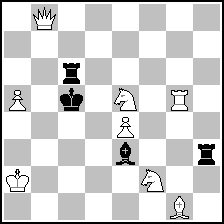 (= 8+4 ) (= 8+4 )
N.A. Macleod
Die Schwalbe
1976
 (= 4+5 ) (= 4+5 )
|
|
| (14) Posted by Geoff Foster [Tuesday, Apr 6, 2010 06:19] |
I'm looking for the best cross-check problems. As Hauke said, the quality should *only* come from the cross-checks and things that revolve around it. One important criterion is that the key should allow at least some of the checks. I also think that to qualify as one of the very best cross-checkers, there must be at least 3 cross-check variations. Here is a really beautiful example.
Comins Mansfield, 2 Prize, BCF Ty, 1927
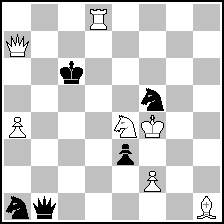 (= 7+5 ) (= 7+5 )
1.Ke5! (2.Rc8)
1...Qb2+ 2.Sc3
1...Qb5+ 2.Sc5
1...Qb8+ 2.Sd6
1...Qxe4+ 2.Bxd4
1...Qb6 2.Qd7
1...Qb7 2.Qc5
1...Sd6 2.Rxd6
|
|
| (15) Posted by Miodrag Mladenović [Tuesday, Apr 6, 2010 07:17]; edited by Miodrag Mladenović [10-04-06] |
Here is my problem showing this theme:
Miodrag Mladenovic
1st Pl. Liga Problemista 1997
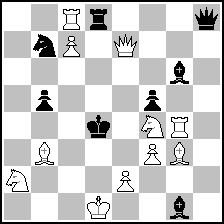 (= 11+8 ) (= 11+8 )
#2
1.Qg5! [2.Se6#]
1...Kc5+ 2.cxd8Q#
1...Ke5+ 2.Sd3#
1...Ke3+ 2.Sd5#
Please note that there are checkmates by three different white batteries.
|
|
| (16) Posted by Jacques Rotenberg [Tuesday, Apr 6, 2010 10:05] |
Are you sure ?
I can find 4 !
|
|
| (17) Posted by Branislav Djurašević [Tuesday, Apr 6, 2010 10:19] |
Misha, I think there are even four batteries; in threat one more(after 1.Qg5! Qg8 or Re8, 2. Se6# battery works).
|
|
| (18) Posted by Miodrag Mladenović [Tuesday, Apr 6, 2010 11:30] |
Well, I counted only thematic mates after thematic variations. Yes, there is the fourth battery in the threat.
|
|
| (19) Posted by Juraj Lörinc [Tuesday, Apr 6, 2010 16:47] |
The question is, however, whether variation 1...Kc5+ 2.cxd8Q# contains cross-check or not. The issue is that the mating move captures black checking unit. What do the strategic experts say?
|
|
| (20) Posted by Hauke Reddmann [Tuesday, Apr 6, 2010 19:54] |
They say "Nope, choss-check MUST be capture free."
(Obviously, nothing speaks against having additional
such variants, it's just then a...counter check?
D: Gegenschach vs. Kreuzschach)
Hauke
|
|
Read more... |
Page: [Previous] [Next] 1 2
MatPlus.Net  Forum Forum  General General  Best #2 cross-check problems Best #2 cross-check problems |
 ISC 2024
ISC 2024 Forum
Forum  General
General  Best #2 cross-check problems
Best #2 cross-check problems 


